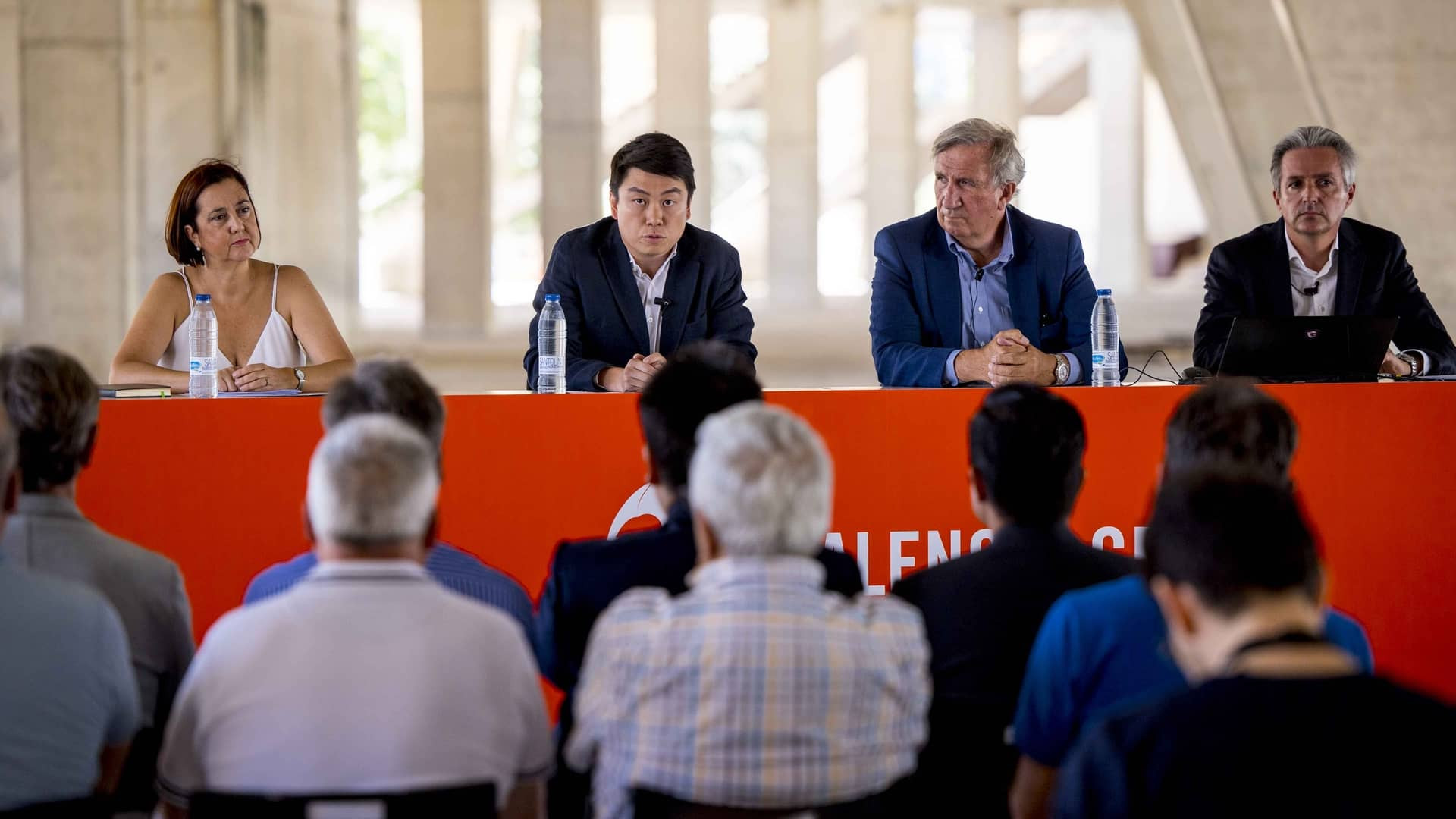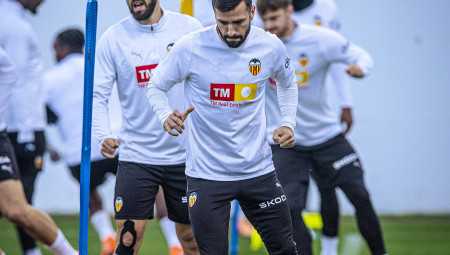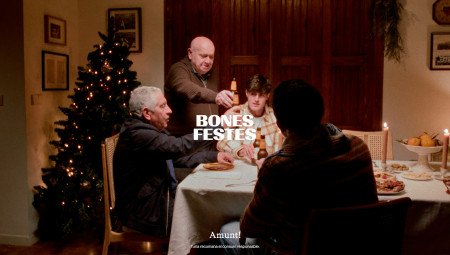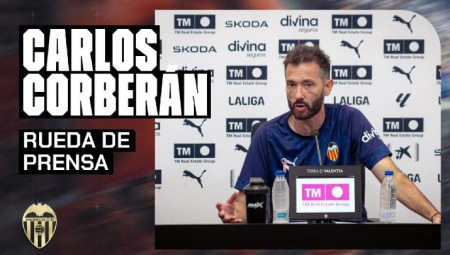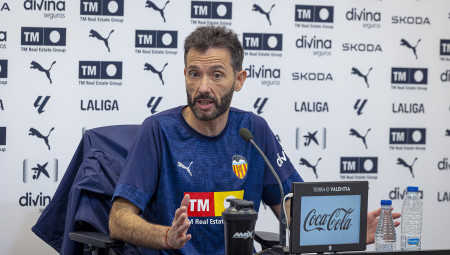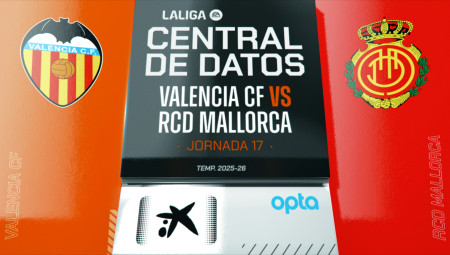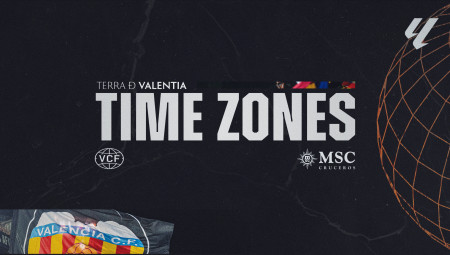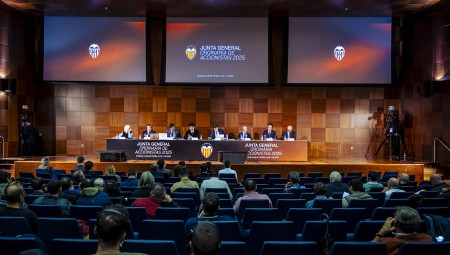This Thursday, the presentation of the new stadium project was made to the media, with General Director Sean Bai, architect Mark Fenwick, Director of Operations Christian Schneider and Financial Director, Inmaculada Ibañez, answering questions at the press conference:
If you start with a capacity of 49,000 spectators and the administrations say that it has to be 70,000, how do you fix that problem?
Christian Schneider: “The idea is to start with 49,000 and move up to 70,000 when necessary. The bulk of it has already been done. In terms of deadlines, they are set at between 20 and 22 months from when we have the licenses until we finish. The red lines are the negotiations.
They come from an agreement that was signed in 2005, the construction comes after the extension of works that enjoyed all the administrative licenses and that the Supreme Court declared illegal. So a process was begun to find solutions together. In 2004 an agreement was signed between the club and the Ministry to build a large stadium that could host major events.
We are not saying that we are not going to have a capacity of 70,000; we are going to do the work in stages. In fact, the current license is for a capacity of 70,000.
Mark Fenwick: “The stadium capacity is 70,000. What is better for Valencia CF at the moment? All you have to do is put in the seats; the stadium is already made for 70,000 spectators. The best thing is to have a full stadium and a perception of fullness.
The reality is that with 70,000 seats today, it would seem empty. After opening with a capacity of 49,000, if we see that there is a huge demand, we can expand to 70,000 in a very short time. As I say, it is only a case of putting in seats. It would take a couple of months. I repeat: It is a stadium for 70,000. You have to find what is best for Valencia CF and the fans so that they feel close together.
That is why we have the staggering of the capacity. Everything is ready. The design is done and we are ready, the dialogue with the Ayuntamiento City Council has been great and in a couple of years we can get there.”
You have mentioned that there were two bridge credit lines with CaixaBank and Rights and Media. Valencia CF, according to the accounts presented at the last General Shareholders' Meeting, had requested a credit of 51 million from Rights and Media. Are the 15 million you refer to part of those 51m?
Inmaculada Ibáñez: “No. This would be a new line of credit specifically for this. It has nothing to do with the other matter. We have already paid a fifth of the other credit line.”
Do you have any calculation as to whether the current socioeconomic situation has generated an extra cost?
Christian Schneider: “We are working around some measurements of a basic project, we have updated the increase in materials according to these ratios and the cost of the roof has also been recently studied with the current price values. If there were any difference that had to be covered, as Inma said before, we would have the two lines of credit to draw on. The cost overrun percentages vary day by day, but once the project is defined, we will know exactly.”
The administration says that the ATE is expired. In the event that it is resolved in advance, will they take the process to justice?
Christian Schneider: “We are working with the administrations. We have presented them with the documentation, and the last time was almost two weeks ago. Our intention is not to go to court over this, but to carry it out and make it a reality as soon as possible. That is what is best for all of us. If they unilaterally decide that it has expired, then we will have to defend our interests.”
Can you explain in detail the issue of the roof? Is there an agreement with a company for its financing?
Christian Schneider: “With regard to the roof, we have offers from several companies for a cover that is very similar to the project that was presented two years ago. The architects are working with the engineering and there is an estimate for the cost of the roof, which is between 30 and 35 million euros.
The roof is included in the project, what we have presented is not what I could achieve with the help of a third party, but what Valencia CF are going to do. We are working with partners for the photovoltaic panels, because we want to build a large solar farm. As I say, we are talking with partners, but the roof is within the club's numbers.”
What is the club's policy regarding the construction of the new stadium? Is the idea to put on a good face and then go to court? What guarantees do the fans have that this time you are serious?
Sean Bai: “The Club do not want to go to court over the process; on the contrary, a good example of this is that until now we have always tried to work hand in hand with the administration to make a strategic and beautiful project for Valencianistas. The club have to defend our interests, we want to seek agreements and carry out this project with all the parties involved.
If, despite our willingness to reach an agreement and having presented a credible project from a technical and financial point of view, the administration goes ahead with the expiration of the ATE, the club will be forced to appeal a disproportionate and unjustified decision.”
If it is so easy to increase the capacity, why not open with 70,000 seats?
Christian Schneider: “The first thing is the sporting issue, which we already saw during the pandemic: There was a sad and bleak atmosphere. It doesn't make much sense to have an empty stadium. In the previous project we were not talking about 49,000 spectators in the first stage and a final capacity of 70,000, but rather we were talking about an opening phase of 42,000 and a final capacity of 66,000. We have been adapting the project because the administrations asked us for more.”
Mark Fenwick: “I insist, we are talking about a stadium that is 70,000 capacity. Let's make the best stadium for Valencia CF. If as soon as it opens there is a demand of 70,000 fans, then let it be done like this. The capacity numbers are clear, hopefully those statistics will rise in the coming years, but you have to have a full stadium. The fuller, the better."
Is the athletics track still included in the project?
Christian Schneider: “It is the same thing that we had in the project with which they gave us the license. The track is like the one at Wembley Stadium: A platform is set up that covers the entire lower stand level.
The obligations we have is that, if the case arises, if the City Council needed to hold that event at the stadium, they would build the track at their own expense, but the stadium has to be capable of it and it is.”
Mark Fenwick: “The geometry of the 'bowl' allows for a large platform, which would take 2 or 3 months to build, but it is possible, like at Wembley. The first part of the stands would be below the platform.”
Is it the same project as was presented two months ago?
Christian Schneider: “The project itself is, yes. For licensing purposes. But it has been adapted. Before, capacities were presented of 42,000 at the opening and a final capacity of 66,000, and now we have 49,000 at opening and a final capacity of 70,000.
The cost of a stadium, so that we are all clear, is measured in euros per seat. Considering a capacity of 70,000, which is what the stadium is designed for, the new Mestalla will be around 3,500/4,000 per seat, a similar ratio to the new San Mamés or the Wanda Metropolitano, which are not exactly bad stadiums. It is not a 'low cost' stadium. It meets FIFA and UEFA requirements and for a country with the costs of Spain, it is a top level stadium.”
What is the position of the club regarding those who say that the ATE has expired?
Sean Bai: “This is not a matter of interpretation, it is objective data. The ATE has not expired. At the end of last year, the Administration initiated an early resolution procedure for the ATE, which has not yet been completed. Within this procedure, the club presented a set of documents that show that show that we comply with the main points of the ATE, with a very solid project from a technical and financial point of view.
Until the administration analyses the documentation presented by the club and a resolution is issued that effectively declares the anticipated resolution of the ATE, it cannot be considered expired, otherwise that would deny a hearing process to Valencia CF and our right to defence.”
Inmaculada Ibáñez: “At this point, the first thing we should know is what they asked Manuel Illueca. He is a great professional. If Illueca was asked: ‘Is what Valencia CF have presented the equivalent of a financial guarantee?’ then he answered well. If he was asked if it is economically viable and if Valencia CF can start the work and finish the stadium, it is a very different question.
We have 80 million in the bank. We have the tertiary area to cover 100% of the project. We have the office building and the lines of credit. Illueca answered well. He said he was willing to sit down to find solutions, I was with him and he told me so too. They are interested in finishing the stadium, as are we, the city and Valencia CF fans. We must be open to unblocking this situation. Who isn’t interested in the stadium being finished?”
What is the situation for Valencia CF regarding Financial Fair Play, and how much do you have to sell before the end of the season?
Inmaculada Ibáñez: “We are not here to talk about FFP. Many of you have been to Madrid and they have explained to you what it consists of. We are in a bad situation, I will not deny it. Regarding the question of how much we have to sell, or if you have to sell before June 30th, it is an internal issue to the company. I'm sure that at the next General Shareholders' Meeting I'll justify everything, but right now I can't give you details.”
If the stumbling block is the number of seats, why don't you raise the starting capacity to 70,000?
Christian Schneider: “The stands have 74,000 capacity. In its day it was already done to comply with that agreement and the needs that were agreed upon. That was agreed with the administrations, everything was agreed with the administrations and what has been built already complies with the agreement. It is a matter of putting in more or fewer seats. Since 2004 a lot has happened.
The agreement specifies that it has to be a stadium for 70,000, and the stadium is that. Over time, everything changes and we have to adapt, just as we have adapted to the needs that the Ayuntamiento City Council have had at all times with the issue of the sports centre. We have to adapt to our demand for season ticket holders. If we have to increase the number of seats, then we will do it, no problem. It's a matter of months."
What will be the number of parking spaces that the new stadium will have?
Christian Schneider: “In the 2007 general plan amendment, the construction of 3,500 parking spaces was required. In the processing of the licenses, the City Council itself was very concerned about putting 3,500 cars under the stadium. It is a security issue. With 3,500 vehicles it is crazy, because people enter the stadium at game time and leave as soon as it ends, two minutes later.
When we were working on the project, the change of direction for the street was even considered to speed up exiting, because the entire area was collapsing. Now there is talk of sustainability, public transport... A mobility study was carried out and the non-enforceability of parking spaces for stadium use was justified and approved with the ATE. Now there is a number of 300-400 raised.”
Mark Fenwick: “We have improved a lot in terms of sustainability, and having 3,000 cars enter is not feasible. I recently said that the new Santiago Bernabéu had 500 parking spaces. I was wrong, I spoke with the architect and he told me that there are 490.”
What is the current status of the concrete quality?
Christian Schneider: “Two years ago a detailed study of the state of the building's construction was carried out, including destructive tests. It's fine, there is neither a risk of collapse nor is it at risk of falling down. It's in good condition.”
Have Valencia CF made a written commitment that if a series of milestones are met, the capacity will be increased to a total of 70,000?
Christian Schneider: “We have not presented a commitment, but we are open to negotiations. We believe that 20,000 seats should not be the problem for the construction of this stadium to be blocked.”
Why does Peter Lim, as the majority shareholder, not acquire the commitment to guarantee the construction of the new stadium?
Inmaculada Ibáñez: “Valencia CF are who have the commitment to build the stadium, not Peter Lim. I've been here for 22 years. The club have to face our problems. I am very grateful that Peter Lim is here, that he gives support and loans, most of which have been capitalised. We are mistaken if we think that Peter Lim has to guarantee this. It is Valencia CF who have to guarantee this project.”
What is the distance between the stands and the goals?
Mark Fenwick: “We have used the minimum possible that FIFA and UEFA regulations allow us. There is a distance for advertising, photographers etc, And we have kept the distance to a minimum so that the lower stand is as close as possible to the pitch.”
Why are the same things presented that were presented initially?
Christian Schneider: “Those who have to give the building and activity license are the Activities service. They gave it initially, and years ago it was negotiated to present a modified plan. The Ayuntamiento City Council told us that we could build now, but there is a change of plan. The City Council have to inform us it complies with the new plan. In addition, there has been a change in construction regulations.
We want to build a stadium that is new, not an old one with the 2007 regulations. And the third point is evacuation of the stadium. With balconies there are external stairs, which for evacuation purposes must be reported -and we have informed Activities.
The ATE gives us a guarantee. It is approved and gives us that guarantee. You face a much longer term. This generates insecurity and generates longer processing times. If we want to finish it now, we have to do it based on the ATE.”
Do you fear that any of the opposition groups may bring action to try to take the club to court?
Sean Bai: "We don't think about this scenario. The important thing for Valencia CF is to go hand in hand with the Administration.”
Inma Ibáñez: “Who can be a Valencianista and have an interest in the stadium not being finished? That doesn't enter my mind.”
Have you come up with an alternative seating configuration where you can't be penalised for camera shots of empty stands?
Christian Schneider: “The camera shot is the area in front of the main stand, it's in the upper area. The image is also ugly even when you put the seats in the upper area. I don’t understand that 20,000 seats can be a stumbling block for not moving this forward.”
If you don't see it as a stumbling block, why don't you try to modify the agreement with the administration?
Christian Schneider: “It would not be necessary to modify the agreement. They are shades of grey, depending on who is reading it, from their perspective. We are open to talking with the Administrations to find solutions to this.”
What is the situation with the sports centre in Benicalap? Has the cost increased due to changes in the Ayuntamiento’s needs?
Christian Schneider: “Now it is more expensive than the initial project. What we have communicated to them is that we are willing to pay what was signed. There was a series of needs, then an agreement that we would build for those needs on our own. We are willing to pay for that.”
Is there a Plan B to face this project without the ATE?
Inmaculada Ibáñez: “Valencia CF are going to build the stadium, with or without the ATE. It wouldn't make sense for me to mortgage for 50 years with CVC if we weren't going to do it. We are going to build the stadium. The club have offered the administration the guarantee that, if we do not comply, we will not enjoy the urban planning benefits.
In terms of land, benefits are in Mestalla, not the new stadium. It is the same buildability, that does not change. We have offered to the Administration that they do not expire the ATE, which expires in 2025, and if we have not finished the stadium before then, that it expires.
If the ATE expires, we would have to request the licenses based on the new parameters, but the stadium will be built. The problem we would have is that it will take longer. Let's focus on this topic.
The ATE gives us legal certainty on the urban planning issue and to sell the tertiary areas. If we want to start now, it is the easiest solution. That does not mean that without ATE we will not do it. We have 80 million there waiting for us.”
Why doesn't Lim endorse the new stadium?
Sean Bai: “It's a simple answer. From our side, as Inma explained before, the construction of the new stadium is a club issue. At this time, you have to look for all possible solutions before coming up with a Plan B.
In order to find all the solutions that we have already found, then we will see the next steps and evaluate if we need other things. The intention is the same: to build and finish the new stadium.”
Do the club understand that the Administration may require more guarantees to maintain the urban planning benefits?
Inmaculada Ibáñez: “We don't want the buildability of Mestalla now. We want it when we can show that we have built the stadium. That's not a problem. I cannot deposit guarantees; that is impossible. If we want to build based on the impossible, we will never do anything. I have 80 million, which is a lot of money.
I have a buyer for the tertiary sector, an office building for sale and important entities that support me to carry out a viable project. I am not asking them to give us the buildability for Mestalla now.
The best guarantee is that we will finish the stadium. What will be built at Mestalla will be what the Administrations want. And that will depend on the ATE. For Valencia CF there is only one plan: build the stadium.”
Of all the projects that we have seen over the years to build this stadium, is this the best?
Christian Schneider: “Each person has their own tastes. Technically, for space allocation purposes, it is the same as the first project. Things evolve, in terms of materials. Visually, it's a matter of taste. It is not worse than the previous ones because it has evolved. It's at least the same as the others. For visual effect, I like the roof and the balconies.”
Sean Bai: “The technical part has already been explained by Christian. If it is the best stadium, in the end that will be seen in the atmosphere that we are going to share here with the team and the fans. We are going to offer a very nice, exciting place for the club and the fans, and the next step is how to integrate all the people into this facility.”
Mark Fenwick: “It is a stadium with the same facilities, but we have improved the performance of the stands when it comes to enjoying watching football. This space is magnificent and unique.
Very few stadiums have this double-height space with views of the pitch. It is much more sustainable because of the solar roof. The idea of being able to look out on the balconies, that it be more open and that it has visibility in both directions, is spectacular. The roof is better. It's a magnificent stadium."
Four months ago Mark Fenwick said that the stadium did not have canvases. and in the project presented to the Administration it did. Which is right?
Mark Fenwick: “It's amazing, the only question I get sometimes is this. There is a stand with no space. As an architect, I am not going to put up canvases. If the club want to use that space to create colour, put sponsors’ names there or something like that, they will put up canvases and it can look good. In my project there are no canvases. The stretched cover that there is in many World Cup is a textile cover. What you are talking about is not part of the stadium."
Have licenses been requested for restaurants?
Christian Schneider: “The services are already included in the license that we have requested and there are other spaces that face outside that, until the operator comes in, will be subject to the user license they will have.
We have defined the uses of corners. They will be concession points for the public. Obviously, when the stadium opens, it will have its restaurant, its store and all the services that are needed.”
Is one of the stands going to be a Grada de Animación?
Christian Schneider: “We have to negotiate the north end with the police and the league. This is a security problem. Our Grada de Animación will be in the lower stand at the north end. I can’t tell you the capacity, as that will be decided as it evolves.”
Of all the stadiums you have built around the world, where do you place it?
Mark Fenwick: “It's like saying which of y children I like best. I have a very special affection for this stadium, for the time we have spent on it. It is a ground that, when it is finished, will be one of the most spectacular. It's the biggest we've ever created in the studio."
If this process ends up in court, could construction begin at the same time?
Christian Schneider: “Not immediately. We have presented a license subject to current planning, which is the ATE. If it expires, a new license would have to be processed. We would take more time. The ATE gives us the legal certainty to build the stadium now.”
Why don't you agree to negotiate something that is not the ATE?
Christian Schneider: “A new figure requires a new procedure, and that mean deadlines. The legally required guarantees are the endorsement that we already deposited. I understand that the Administration is worried, but legally they cannot demand a guarantee of 115 million euros.
The endorsement concept is a guarantee for comparison, you do not deposit all the money. It is not workable. What we are trying to explain is that we have sufficient financial capacity to make this a reality. If we already have the money deposited for 70% of construction, what is the problem?
If liquid guarantees are required of us, nobody is capable of doing anything. It is unfeasible. Nobody is capable of that. We look forward to working together. If it goes to court or there is a new figure, those are problems. The lucky thing is that now we have the money to finish it and we hope to go hand in hand to make it a reality.”
Have CaixaBank given the bridging loan on the condition of the existence of the ATE?
Inma Ibáñez: “Yes. In their commitment letter, which is the one approved by all their committees, including the board of directors, it is subject to the existence of the ATE. We have asked them for financing in an environment in which there is an ATE, which is what makes it possible for this to work within the timeframes that I have asked for.
If they don't give the ATE, we would have to sit down again and look at conditions. We do not contemplate that the ATE not be there. We do not contemplate that we will not reach an agreement with the Administration. We'll see what they tell us."
The idea was that work would resume in October. Would you still be on time?
Christian Schneider: “We would no longer be able to inaugurate in 2024, as was proposed months ago. It would be the summer of 2025. The transition must be done between seasons, as there are facilities that are not ours that belong to LaLiga, such as turnstiles or the Spider Cam, which would have to be moved and adapted. That is done in the summer between seasons.”
In the event that the authorities do not validate this project, would the club consider a change of promoter?
Christian Schneider: “Which promoter? It would be the authority that would say that it is unfulfilled and change the promoter. But it is not that simple. What administration is going to put finishing the stadium in its budgets and turn the bill over to Valencia CF? I don't see any sense in that. What we also say is that we want to finish the project now.”
Latest news Ver todas
Latest news Ver todas
Carlos Corberán: “We are eager to give the fans the three points”
Valencia CF head coach press conference ahead of the match against RCD Mallorca
STATS AHEAD OF VALENCIA CF - RCD MALLORCA
18 December 2025When and where to watch Valencia CF - RCD Mallorca live
Matchday 17 – LALIGA EA SPORTS 2025/26
This Christmas, come with your family to the third edition of ‘Mestalla, Camp de Nadal’
Free admission and open to all audiences
Highlights of the 2025 General Shareholders’ Meeting
www.valenciacf.com
